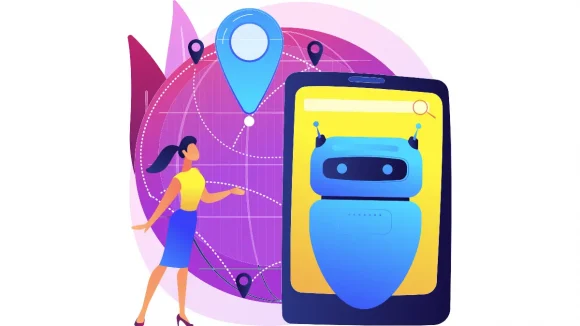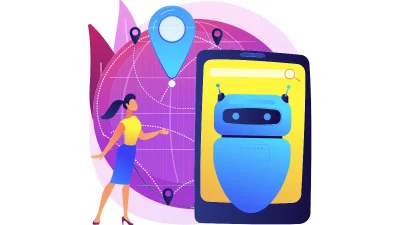In today’s interconnected world, global supply chains have become increasingly complex and dynamic. To meet the demands of this ever-evolving landscape, logistics processes and supply chain management have embraced the power of AI solutions. AI in logistics has paved the way for innovative approaches to supply chain visibility, enhancing the efficiency and effectiveness of logistics and supply chain operations. From robotic process automation to the use of autonomous vehicles, AI technologies are transforming traditional logistics practices. This article will look at how robotics and artificial intelligence are revolutionizing the logistics industry!
These advancements not only optimize traffic flow and minimize delays but also enable logistics companies to streamline their operations, reduce operational costs, and deliver goods with unprecedented speed and accuracy. With AI at the helm, the future of logistics and supply chain management looks promising, as businesses strive for greater visibility, efficiency, and competitiveness in the global market.

How Robotics and Artificial Intelligence are Revolutionizing the Logistics Industry
Let’s take a look at how robotics and artificial intelligence are revolutionizing the logistics industry.
From Fiction to Reality:
While science fiction often portrays robots as either heroes or villains, the reality is far more practical. Robots are finding their place in the logistics sector, taking over repetitive and hazardous tasks previously performed by humans. These sophisticated machines are streamlining operations and making life easier for logistics operators.
Let’s dive into the world of logistics robotics and discover the benefits they bring.
[Don’t] Kill All Humans!
If you’ve watched the animated TV show Futurama, you’re familiar with the hilarious and somewhat mischievous robot, Bender. But real-life robots are far more useful and less interested in plotting the downfall of humanity. In the logistics and parcel delivery industry, robots are delivering a range of benefits.
Streamlining Operations
Large sorting and distribution centers are increasingly using automated systems as a result of developments in robotics technology. Tasks like sorting, picking, packaging, loading, and unloading packages can be automated with the help of these robots, AI, and software systems. Logistics organizations may lower labor costs, enhance accuracy, boost productivity, and maximize space use by incorporating robots into these processes.
Speed and Efficiency
By reducing delays, congestion on conveyor belts, and human error, robotic technologies are changing delivery operations. This guarantees that products move quickly through processing facilities and arrive at their destinations on schedule. In addition, the use of drones and robots as prospective delivery services for distant or difficult-to-reach locations that may avoid traffic and other impediments is being investigated. This development holds considerable promise for the future of robotic parcel logistics, even though there are still several obstacles to be addressed.
Enhanced worker safety
Enhancing worker safety is one of the main benefits of robotics, along with sustainability. Risky or dangerous jobs can be handled by robots, which lowers the possibility of accidents or strain-related injuries. Robots also reduce waste, noise pollution, fuel usage, pollutants, and other environmental negatives. Artificial intelligence (AI)-driven software tools improve sustainability efforts by optimizing routes, planning effective delivery, and keeping track of supply chain indicators.
Digital transformations
Robotics and AI are beginning to take off in the logistics industry, despite the fact that this is still in its early phases. Distribution facilities can already employ some systems, such as AGVs (Automated Guided Vehicles). Similar to how forklifts driven by people move packages and cargo around warehouses, these intelligent machines can do the same. AGVs improve worker safety, make the most use of available resources, and eliminate the need to hire and train forklift operators.
Tipping Points
In places like Australia Post’s Redbank sorting center, robotic tipping arms have changed the game. These arms can tip a variety of pallets and cages containing items onto sorting lines at an astounding rate, thus lowering the need for human intervention and strain-related accidents. Such robots have completely changed how packages are handled, indicating their potential to boost productivity and efficiency.
Robotic Pickers
European package logistics companies are actively testing robots that can take the place of labor-intensive manual jobs like picking and sorting. These machines are programmed to handle a variety of packages, including ones with complex shapes or wrapping, in the same way as human operators would. These robots gradually develop the intelligence and dexterity to recognize and respond to various parcel profiles while continuously honing their abilities and knowledge through machine learning.

The Way Forward
The robotics and artificial intelligence (AI) industries are at the forefront of a significant shift. These developments provide businesses and customers with delivery options that are quicker, more affordable, safer, and environmentally benign.
Robotic technology still has a lot of untapped promise for transforming the processes involved in handling and distributing packages. But there’s no doubt that robots are already improving logistics operations’ functionality and changing the automation landscape.
As robotics gains popularity, these devices are expected to be indispensable tools for Courier, Express, and Parcel (CEP) companies looking to boost productivity, lower operating expenses, and increase throughput. By using robotic devices, businesses can reduce the number of workers needed to produce and handle high volumes of products, easing workforce difficulties.
The phrase “End all of humanity” won’t be followed by these robots. Instead, they are positioned to effect good change and aid in bringing about a new era of efficiency and innovation in the logistics sector.
How Robotics and Artificial Intelligence are Revolutionizing the Logistics Industry: Conclusion
The handling, processing, and delivery of commodities are being transformed by the integration of robotics and AI in the logistics industry. These complex devices are transforming the industry by streamlining processes and enhancing sustainability and safety. Robotics provides enormous promise for improving productivity, cutting costs, and optimizing resource use even if technology is still in its infancy.
We’re on the verge of a logistics revolution as we continue to investigate the potential of robotics and AI. A future with faster, safer, and more sustainable logistics operations will be made possible by embracing these technologies. So let’s welcome our robot companions as they guide us through the fascinating logistics route that lies ahead.
About the author
Marketing Coordinator at Locate2u having completed a Bachelor of Creative Arts, majoring in English Literature and Creative Writing. I have extensive experience in editing and proofreading, as well as creating content for a range of audiences.











